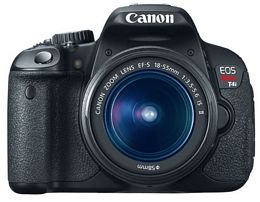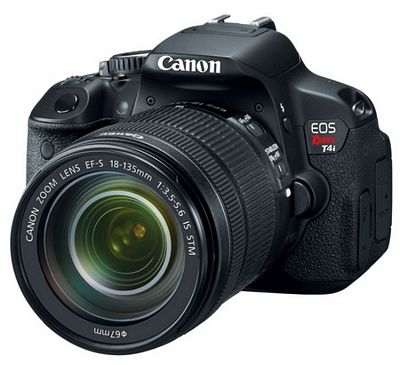Canon has updated its Rebel series with a brand new more video-friendly unit, the Canon EOS Rebel T4i. It’s friendlier, as long as you additionally buy the newer STM lens line made to operate with the up-to-date autofocus system. With one another, the lenses and the camera promise more accurate, smoother autofocus performance within video shooting than seen with usual DSLR systems. This T4i hit stores in multiple configurations: $1,199, $949, and $849. The more expensive lens also is obtainable standalone for $549.99; 40 millimeter f2.8 STM pancake lens retails at $199.99.
Its newer hybrid CMOS sensor involves a couple of sets of autofocus sensors: contrast autofocus array, the kind of autofocus utilized in camcorders and additional video autofocus systems, and the conventional phase-detection spectrum you discover in DSLRs. These, and a change to touch-screen LCD, make this T4i more appropriate for shooting video than prior units. It appears as if the sole bones thrown to photographers include a quicker continual-shooting rate of five frames/second and phase-detection AF system updated with 9 cross-type points, that actually only brings this T4i into parity with additional new cameras with in its category.
The T4i’s presentation naturally impacts the cost of sibling DSLRs. It is likely this EOS Rebel T3i is going to gradually be more reasonably priced and the Canon EOS 60D is going to be a less compelling purchase. Currently, the sole benefits the 60D possesses over thisT4i include improved burst performance – which means a somewhat quicker rate and a deeper buffer — better-built body, and improved battery life.
The lenses integrate a stepper motor for quieter, quicker autofocus within video recording than standard lenses. The company states the optics upon the 18-135 millimeter lens is really a little sharper than the ones upon the non-STM version of its lens– that’s around $50 cheaper. I discover the 40 millimeter lens to be an unusual selection. Why is it a pancake? The body is big enough that you aren’t saving a lot with a tinier lens, and it doesn’t make the camera appear ‘discreet’ as its press release reports. Plus, to make it more compact and possibly less expensive, Canon left out image stabilization that I believe was a mistake.
Although, it is a great touch screen, it’s responsive and with an up-to-date user interface and the typical abilities such as touch focus which streamline Live View shooting. This stated; I do not believe this camera supports peaking that I believe is an important feature for LCD-base shooting.
Contents
Canon EOS Rebel T4i Features
- 18.0 Mp CMOS sensor
- 14-bit A/D con
- ISO 100-12800
- Expandable toward 25600 (H) for recording from bright – dim light as well as a high performance DIGIC 5 Image Proc. for outstanding speed and image
- High speed continual shooting up to 5.0 frames per second permits you to shoot all of the action
- Better AF performance with 9-point all cross-type autofocus system (involving a dual-cross, high-precision f/2.8 center point)
- Hybrid CMOS autofocus boosts AF speed while capturing movies and photos in Live View
- Advanced EOS Full high def. movie mode that has Movie Servo autofocus for continual focus tracking of moving objects
- 3.0” Vari-angle Clear View Touch Screen LCD monitor (around 1,040,000 dots) that has a smudge-resistant coat that has multi-touch operation, as well as Touch autofocus for an intuitive and easy experience, flexible positioning, as well as crystal clear viewing even while outside
To assist in explaining the specific functionality of features on this camera, its feature guide exhibits a simplistic description useful in deciding the applicability for this specific situation. It’s shown in every shooting mode, within the mode dial function, as well as for Rapid Control screen functionalities. It’ll appear automatically as an operation is chosen—a lifesaver while attempting to decide the ideal function or mode for the following photo. Feature guide automatically operates by default, and could be easily disabled via the model’s menu.
Compatible with GPS
With the Global Positioning System Receiver GP-E2 that is optionally connected to the digital terminal, this camera could record location, involving longitude, latitude, and altitude, and could trace the movement trajectory with its logging functionality. The electric compass captures the model’s orientation within every shot, as well as world time data is recorded via Global Positioning System syncing.
Canon EOS 650D / Rebel T4i vs Nikon D3200
| Canon EOS 650D / Rebel T4i | Nikon D3200 | |
|---|---|---|
| Max Resolution | 5184 x 3456 | 6016 x 4000 |
| Image Ratio | 1:1, 4:3, 3:2, 16:9 | 3:2 |
| Effective Pixels | 18.0 | 24.2 |
| Sensor Type | CMOS | CMOS |
| Sensor Size | APS-C (22.3 x 14.9 mm) | APS-C (23.2 x 15.4 mm) |
| LCD Size | 3 | 3 |
| LCD Dots | 1,040,000 | 921,000 |
| Touch Screen | Yes | No |
| Live View | Yes | Yes |
| Viewfinder | Optical (pentamirror) | Optical (pentamirror) |
| Max Shutter Speed | 1/4000 | 1/4000 |
| Min Shutter Speed | 30 | 30 |
| Storage | SD/SDHC/SDXC | SD/SDHC/SDXC UHS-I compliant |
JPEG Resize
To develop photos appropriate for sharing online or by email, this camera could resize all JPEG files, within camera, of differing pixels (the aspect ratio can’t be altered, just the photo size may be reduced) as it leaves the initial photo untouched.
Set-up for Photobook
Photographers could share their photos in book format with this camera’s Photobook Set-up operation. Photographers easily can select certain pictures, pictures inside a folder, as well as also all images, and specify their layout and sequence. Results could be easily printed in a book format.
Image Rate
To assist in organizing pictures captured to the model’s storage this camera will make it easy to rate the individual photographs from 1 star to 5. Thus, photo browsing, slide shows and printing could be based on these ratings.
Upgrading to a Digic 5 image processor from a Digic 4 additionally brings along with it a few new abilities, involving Sony staples such as multi-shot noise-reduction, as well as night scenery and HDR backlight modes, and Video Snapshot mode that’s carried from the camcorders, as well as the PowerShots for shooting fast clips. As with everybody else, Canon has additionally improved upon its auto mode in order to invoke scenery analysis.

